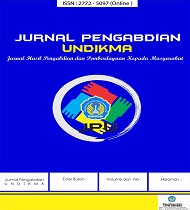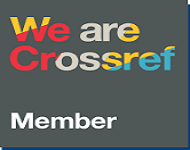Tri Nga (Ngerti, Ngrasa, Nglakoni) Based Teaching Practice Assessment Model
DOI:
https://doi.org/10.33394/jk.v8i4.6243Keywords:
Assessment, Teaching Practice, Tri Nga, Ngerti, Ngerasa, Ngelakoni.Abstract
References
Arends, R. I., & Kilcher, A. (2010). Teaching for student learning: Becoming an accomplished teacher. In Teaching for Student Learning: Becoming an Accomplished Teacher. https://doi.org/10.4324/9780203866771
Astorius Tulus, a. P. H. winingsih. (2020). the Development of Interactive Learning Modul Based on Multimedia Using Tri-Nga Approach on Physics Subject Pengembangan Modul Pembelajaran Interaktif Berbasis Multimedia Dengan Pendekatan Tri-Nga Pada. 7, 1–7.-
Black, P., & Wiliam, D. (1998). Assessment and Classroom Learning. Assessment in Education: Principles, Policy & Practice, 5(1), 7–74. https://doi.org/https://doi.org/10.1080/0969595980050102
Borg, W.R. & Gall, M.D. (1983). Educational research an introduction (4th Ed.). New York, NY: Longman, Inc.
Darling-Hammond, L. (2006). Constructing 21st-century teacher education. Journal of Teacher Education, 57(3), 300–314. https://doi.org/https://doi.org/10.1177/0022487105285962
Djohar, & Istiningsih. (2017). Filsafat pendidikan Ki Hadjar Dewantara dalam kehidupan nyata. Suluh Media.
Gavina, A. L. (2021). Penerapan Tri Nga Pada Pelajaran Dasar Desain Kelas X Smk N 1 Sewon Bantul. 7(2).
Julaeha, S., & Sapriat, A. (2016). Pengembangan Model Asesmen Kemampuan Mengajar Mahasiswa-Guru Di Fkip Universitas Terbuka. Jurnal Pendidikan, 17(2), 81–92.
Lang, W. S., & Wilkerson, J. R. (2008). Accuracy vs. validity, consistency vs. reliability, and fairness vs. absence of bias: A call for quality. Online Submission.
Lee, H., Chung, H. Q., Zhang, Y., Abedi, J., & Warschauer, M. (2020). The Effectiveness and Features of Formative Assessment in US K-12 Education: A Systematic Review. Applied Measurement in Education, 33(2), 124–140. https://doi.org/10.1080/08957347.2020.1732383
Leung, C. (2007). Dynamic Assessment: Assessment for and as Teaching? Language Assessment Quarterly, 4(3), 257–278. https://doi.org/10.1080/15434300701481127
McMillan, J. H., & Hearn, J. (2008). Student self-assessment: The key to stronger student motivation and higher achievement. Educational Horizons, 87(1), 40–49.
Nadziroh, N. (2017). Implementasi Ajaran Ketamansiswaan Tri-Nga untuk Menanamkan Budi Pekerti Luhur dalam Perkuliahan Pendidikan Kewarganegaraan. Taman Cendekia: Jurnal Pendidikan Ke-SD-An, 1(2), 93–101. https://doi.org/10.30738/tc.v1i2.1942
Nisa, A. F., & Prasetyo, Z. K. (2020). The Teachings of Ki Hadjar Dewantara in Improving the Character of Elementary School Students in the Revolution of Industry 4.0 Era. International Conference on Educational Research and Innovation (ICERI 2019). https://doi.org/https://doi.org/10.2991/assehr.k.200204.010
Putri, H., Susiani, D., Wandani, N. S., & Putri, F. A. (2022). Instrumen Penilaian Hasil Pembelajaran Kognitif pada Tes Uraian dan Tes Objektif. Jurnal Papeda: Jurnal Publikasi Pendidikan Dasar, 4(2), 139-148.
Rahmawati, E. V., Ernawati, T., & Ayuningtyas, A. D. (2020). LKPD berbasis ngerti , ngrasa , nglakoni ( Tri Nga ) untuk mengembangkan keterampilan proses sains kelas VIII SMP. Jurnal Pendidikan IPA Veteran, 4(2), 190.
Scritchfield, S. A. (2002). Assessment of student learning: What, how, why bother. In Workshop Sponsored by the Creighton College of Arts and Sciences and Office for Excellence in Teaching, Learning, and Assessment. Omaha, Nebr.
Stobart, G. (2010). Deploving Teacher Assesment (1st ed). Open University Press.
Suparlan, H. (2016). Filsafat Pendidikan Ki Hadjar Dewantara Dan Sumbangannya Bagi Pendidikan Indonesia. Jurnal Filsafat, 25(1), 56. https://doi.org/10.22146/jf.12614
Thorndike, R. L., & Hagen, E. (1969). Measurement and evaluation in psychology and education.
Turnipseed, S., & Darling-hammond, L. (2015). Accountability Is More Than a Test Score.
van de Grift, W., Helms-Lorenz, M., & Maulana, R. (2014). Teaching skills of student teachers: Calibration of an evaluation instrument and its value in predicting student academic engagement. Studies in Educational Evaluation, 43, 150–159. https://doi.org/https://doi.org/10.1016/j.stueduc.2014.09.003
Yusnaldi, E., Putri, F. A., & Iskandar, W. (2021). Analisis Program Pembelajaran Berbasis Higher Order Thinking Skills di MI At-Taqwa GUPPI Wojowalur Daerah Istimewa Yogyakarta Tahun Ajaran 2018/2019. AR-RIAYAH: Jurnal Pendidikan Dasar, 5(1), 97-120.
Downloads
Published
How to Cite
Issue
Section
Citation Check
License
License and Publishing Agreement
In submitting the manuscript to the journal, the authors certify that:
- They are authorized by their co-authors to enter into these arrangements.
- The work described has not been formally published before, except in the form of an abstract or as part of a published lecture, review, thesis, or overlay journal.
- That it is not under consideration for publication elsewhere,
- That its publication has been approved by all the author(s) and by the responsible authorities tacitly or explicitly of the institutes where the work has been carried out.
- They secure the right to reproduce any material that has already been published or copyrighted elsewhere.
- They agree to the following license and publishing agreement.
Copyright
Authors who publish with JK agree to the following terms:
- Authors retain copyright and grant the journal right of first publication with the work simultaneously licensed under a Creative Commons Attribution License (CC BY-SA 4.0) that allows others to share the work with an acknowledgment of the work's authorship and initial publication in this journal.
- Authors are able to enter into separate, additional contractual arrangements for the non-exclusive distribution of the journal's published version of the work (e.g., post it to an institutional repository or publish it in a book), with an acknowledgment of its initial publication in this journal.
- Authors are permitted and encouraged to post their work online (e.g., in institutional repositories or on their website) prior to and during the submission process, as it can lead to productive exchanges, as well as earlier and greater citation of published work.
Licensing for Data Publication
-
Open Data Commons Attribution License, http://www.opendatacommons.org/licenses/by/1.0/ (default)

This work is licensed under a Creative Commons Attribution-ShareAlike 4.0 International License.







